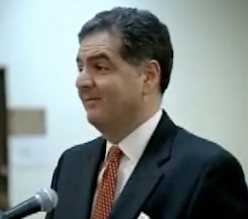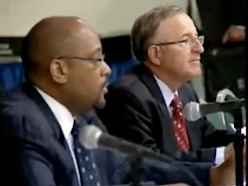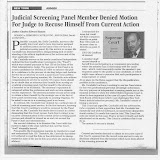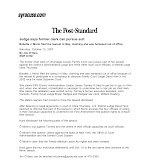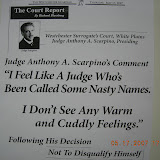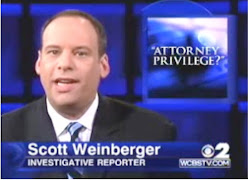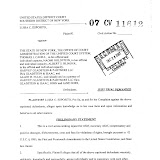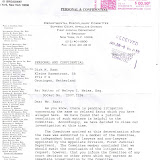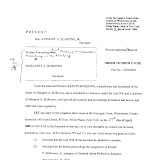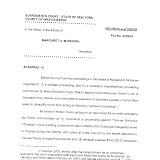08 Civ. 3305 (SAS) (dated April 6, 2010)
PAMELA CARVEL, Plaintiff,
-against-
NEW YORK STATE; OFFICE OF COURT
ADMINISTRATION OF THE UNIFIED
COURT SYSTEM OF NEW YORK;
THOMAS J. CAHILL, individually and in
his official capacity; SHERRY M. COHEN,
individually and in her official capacity;
GARY L. CASELLA, individually and in his
official capacity; EVE MARKEWICH,
individually and as a partner of BLANK
ROME LLP; FRANK STRENG,
individually and as a partner of
McCARTHY FINGAR LLP; DEBORAH
McCARTHY; JOEL AURNOU; WILLIAM
GRIFFIN, individually and as a co-owner of
HUDSON VALLEY BANK; LAURA
WERNER, individually and in her official
capacity; ANTHONY SCARPINO,
individually and in his official capacity;
CHARLES SCOTT, individually and in his
official capacity; and JOHN/JANE DOE,
DOE COMPANY 1-20,
Defendants.
SHIRA A. SCHEINDLIN, U.S.D.J.:
I. INTRODUCTION
Plaintiff Pamela Carvel, proceeding pro se, brought suit against the above named defendants pursuant to, inter alia, 42 U.S.C. § 1983 (“section 1983”),1 alleging various constitutional violations including the denial of due process and equal protection of the laws under the Fourteenth Amendment.2 Carvel also asserts a number of state law claims.3 The instant case, along with five other cases, were filed as related to Anderson v. State of New York, 07 Civ. 9599 (SAS).4 On August 8, 2008, this Court dismissed this and the five other actions in an omnibus Opinion and Order.5 Carvel appealed to the Second Circuit which, on March 12, 2010, issued a Summary Order, affirming in part, vacating in part, and remanding this case to this Court.6
The Second Circuit affirmed the dismissal of plaintiff’s Amended Complaint in all aspects but one, stating as follows:
we cannot affirm the District Court’s dismissal of plaintiff’s conspiracy allegations under §1983. Plaintiff alleges a “strong appearance of bribery” surrounding $400,000 in loans given to Justice Scarpino. App. 26 (Compi. 7~ 69-70). Although Justice Scarpino enjoys the benefit of absolute judicial immunity from that claim, the other defendants involved in the alleged “bribery” scheme do not. See Dennis v. Sparks, 449 U.S. 24, 28-29 (1980). Because the District Court did not explicitly address this claim before dismissing it sua sponte, we lack a basis on which to affirm its dismissal. We therefore vacate the dismissal with respect to the “bribery” claim and remand for the District Court to address Ihe claim in the first instance.7 This Court must therefore apply the holding of Dennis v. Sparks8 to plaintiff’s allegations and determine whether any part of her conspiracy claim should survive.
II. LEGAL STANDARDS
A. Motion to Dismiss
The first question is whether plaintiff’s allegations meet the plausibility standard recently adopted by the Supreme Court. In deciding a motion to dismiss pursuant to Rule 12(b)(6) of the Federal Rules of Civil Procedure, a court must “accept as true all of the factual allegations contained in the complaint”9 and “draw all reasonable inferences in [the] plaintiffs favor.”10 However, a court need not accord “[l]egal conclusions, deductions or opinions couched as factual allegations . . . a presumption of truthfulness.”11 To survive a Rule 12(b)(6) motion to dismiss, the allegations in the complaint must show that the plaintiff is plausibly entitled to relief.’12 A claim is facially plausible “when the plaintiff pleads factual content that allows the court to draw the reasonable inference that the defendant is liable for the misconduct alleged.”13 Plausibility “is not akin to a probability requirement,” rather plausibility requires “more than a sheer possibility that a defendant has acted unlawfully.”14
B. Conspiracy Under Section 1983
In order to survive a motion to dismiss a section 1983 conspiracy claim, a plaintiff must allege: “(I) an agreement between [two or more state actors or] a state actor and a private party; (2) to act in concert to inflict an unconstitutional injury; and (3) an overt act done in furtherance of that goal causing damages.”5 “Thus, a plaintiff must show that defendants acted in a willful manner, culminating in an agreement, understanding or meeting of the minds, that violated [his] rights, privileges or immunities secured by the Constitution or federal courts.”6 “In addition, ‘complaints containing only conclusory, vague, or general allegations that the defendants have engaged in a conspiracy to deprive the plaintiff of his constitutional rights are properly dismissed.”7 While conclusory allegations may be insufficient, “conspiracies are by their very nature secretive operations,’ and may have to be proven by circumstantial, rather than direct, evidence.”8 Finally, “[a] violated constitutional right is a natural prerequisite to a claim of conspiracy to violate such right.”9 “Without deprivation of a federal constitutional right, ‘there can be no civil rights conspiracy to deprive that right.”20 Thus, to survive a motion to dismiss, a plaintiff must allege a constitutional deprivation.
III. DISCUSSION
A. In General
Because plaintiff’s Amended Complaint is prolix and often vague and repetitive, it is difficult to decipher the parameters of the alleged conduct that resulted in particular constitutional violations. However, the thrust of plaintiffs numerous allegations can be summarized as follows: After the suspicious death of plaintiffs uncle, ice cream magnate Thomas Carvel, his multimillion dollar estate was plundered by private attorneys, assisted by various employees of the state court system, to the financial and emotional detriment of his wife, Agnes Carvel, now deceased,2’ and plaintiff, his surviving niece.22 In sum, plaintiff alleges that individual defendants William Griffin, Eve Markewich, Frank Streng, Deborah McCarthy, and Joel Aurnou (collectively, the “Individual Defendants”), all of whom are attorneys in private practice, colluded with Justice Anthony Scarpino of the Westchester County Surrogate’s Court, and other state employee defendants, to “engage in tax fraud, charity fraud, covert agreements, conversion, and fraudulent transfers of Pamela Carvel ‘s assets and other Carvel assets to themselves and their agents, so as to defraud Pamela Carvel as client, fiduciary, creditor, beneficiary, and charitable benefactor.”23
B. The Alleged Bribery
Carvel further alleges that Griffin, Markewich, Streng, McCarthy, and Aurnou “entered into covert verbal and written agreements in the Southern District, orchestrated, endorsed, or condoned by Defendants Scarpino, Scott, and Werner, to withhold ALL funds from Pamela Carvel (and the Carvel family) as fiduciary, creditor, asset owner, and benefactor.”24 Plaintiff also alleges a “strong appearance of bribery” surrounding $400,000 in “loans” given to Justice Scarpino from Hudson Valley Bank, a bank in which Griffin is the controlling shareholder. As stated by plaintiff: Streng entered the picture only when the matters in Thomas Carvel’s estate were going to trial before Surrogate Scarpino. Defendant Scarpino failed to disclose conflicts with Streng and a strong appearance of bribey through about $400,000 in “loans” from Hudson Valley Bank, controlled by Griffin, who was appearing before Scarpino as witness and adverse litigant against Pamela.
Public records appear to show that Scarpino was given a $100,000 “loan” by Hudson Valley Bank prior to taking office. Neither Scarpino, nor Markewich, nor Streng, nor McCarthy, nor Aurnou, nor Griffin, ever revealed to Plaintiff Pamela Carvel that Griffin’s Hudson Valley Bank gave Scarpino that loan or additional loans. Griffin’s Hudson Valley Bank gave Scarpino another $200,000 “loan” in October 2001 to coincide with commencement of the first trials in Thomas Carvel’s estate. None of the Defendants revealed [that] yet another $100,000 “loan” in December2004 was given to Scarpino by Griffin’s Hudson Valley Bank just prior to the commencement of trials in Agnes Carvel’s estate.25
Plaintiff claims that as a result of this alleged bribery, Scarpino denied plaintiffs request for a trial by jury.26 Furthermore, two days before plaintiffs opposition to a motion for accounting and legal fees was due in the Thomas Carvel case, Streng moved to withdraw his law firm, McCarthy Fingar, from representing plaintiff, leaving her without legal representation.27 Despite Scarpino’s previous recusal in the McKeown case because of his close relationship with Streng, Scarpino did not decline to decide Streng’s motion to withdraw in Carvel’s case.28 Plaintiff further alleges that Scarpino and Streng corruptly agreed to apply Streng’s withdrawal of representation in the Thomas Carvel case to other matters, thereby depriving Pamela Carvel of due process.29
C. Plaintiff’s Alleged Injuries
It appears that plaintiff could properly allege a plausible section 1983 conspiracy claim, at least as to Griffin. According to plaintiff, Paul Amicucci is a member of Griffin’s law firm. After Agnes Carvel’s death, Griffin, allegedly acting on behalf of the Thomas and Agnes Carvel Foundation, sold Agnes Carvel’s 19-acre residence in Ardsley, New York, to Amicucci’s brother for two million dollars in 2006, although it was worth ten million dollars.3° On the same day, Amicucci’s shell company assigned the whole property back to Griffin through Hudson Valley Bank as a lease assignment for security for a mortgage from Hudson Valley Bank.31
Upon plaintiff’s discovery of these transactions in 2007, this “real estate scheme” was brought before Justice Scarpino who allegedly “did nothing.”32 With further elaboration, Scarpino’s handling of this “real estate scheme” may be a sufficient overt act done with the intention of causing plaintiff to be deprived of property without due process.33 These allegations could, with further elaboration, sufficiently allege the agreement and acting in concert elements of a section 1983 conspiracy claim, at least between Griffin and Scarpino, when coupled with the above-mentioned bribery allegations concerning $400,000 in “loans” made to Scarpino by the Hudson Valley Bank. Moreover, Griffin could be deemed to be a state actor under Dennis v. Sparks given his alleged collusion with a state-court judge who, but for absolute judicial immunity, would also be a defendant in this action.34 The question, then, is whether plaintiff can allege sufficient facts so as to include Griffin and the remaining Individual Defendants in a conspiracy to violate her constitutional rights.
In sum, the remaining individual Defendants could also be deemed to be state actors if there is a sufficient factual basis to conclude that they conspired with Justice Scarpino, or any other state actor, to deprive plaintiff of a constitutional right. However, the Complaint fails to adequately plead how plaintiff was deprived of her property without due process and what the Individual Defendants allegedly did, with whom, when, and what corresponding constitutional injury it caused.
IV. CONCLUSION
For the reasons given above, plaintiff’s section 1983 conspiracy claim is dismissed without prejudice. Plaintiff may amend her Complaint against the Individual Defendants within the next thirty (30) days.35 An amended Complaint must contain specific factual allegations, consistent with this Supplemental Opinion and Order, detailing the various conspiracies in which each of the Individual Defendants allegedly engaged and that resulted in a constitutional violation.36 The Clerk of the Court is hereby directed to reinstate this case to my active docket as to defendants Griffin, Markewich, Streng, McCarthy, and Aurnou.
Leave to amend should be freely granted when “justice so requires.” Fed. R. Civ. P. 15(a). See also Foman v. Davis, 371 U.S. 178, 182 (1962). This rule is especially applicable to pro se litigants. See Gomez v. USAA Fed. Scm’. Bank, 171 F.3d 794, 795 (2d Cir. 1999) @er curiam) (stating that a pro se complaint should not be dismissed without granting leave to amend when a liberal reading of such complaint “gives any indication that a valid claim might be stated”) (quotation marks and citation omitted, emphasis added). Although Gomez pre-dates the plausibility standard announced in Twoinbly and elaborated upon in Iqbal, the standard for granting leave to amend, albeit somewhat less relaxed now, must still permit pro se litigants at least one chance to “nudge[] their claims across the line from conceivable to plausible[.]” Twombly, 550 U.S. at 570.
I decline defendant Markewich’s suggestion to stay this case pending a decision on a motion to dismiss filed in a subsequently commenced district court action, Carvel v. Ross, 09 Civ. 722 (LAK). See 3/17/10 Letter from Philip Touitou, counsel to Markewich, at I.
Dated: New York, New York
April 6, 2010
SHIRA A. SCHEINDLIN,
U.S.D.J.
Appearances -Plaintiff (Pro Se):
Pamela Carvel
110 West Ninth Street, Suite 177
Wilmington, DE 19801-1618
For Defendant Markewich:
Philip Touitou, Esq.
Hinshaw & Culbertson LLP
780 Third Avenue, 4t1~ Floor
New York, NY 10017 (212) 471-6211
For Defendants Frank Streng and Joel Aurnou:
Joseph J. Brophy, Esq.
McCarthy Fingar LLP
11 Martine Avenue, I 2th Floor
White Plains, NY 10606 (914) 946-3700
FOOTNOTES:
1. Section 1983 states as follows: Every person who, under color of any statute, ordinance, regulation, custom, or usage, of any State or Territory or the District of Columbia, subjects, or causes to be subjected, any citizen of the United States or other person within the jurisdiction thereof to the deprivation of any rights, privileges, or immunities secured by the Constitution and laws, shall be liable to the party injured in an action at law, suit in equity, or other proper proceeding for redress 42 U.S.C. § 1983.
2. The Fourteenth Amendment to the United States Constitution provides, in relevant part, as follows: No State shall make or enforce any law which shall abridge the privileges or immunities of citizens of the United States; nor shall any State deprive any person of life, liberty, or property, without due process of law; nor deny to any person within its jurisdiction the equal protection of the laws. U.S. CONST., amend. XIV, § 1.
3. See Amended Complaint (“Compl.”) ¶¶ 172-203.
4. See Esposito v. State of New York, 07 Civ. 11612 (SAS); Bernstein v.Appellate Div. First Dep ‘t Departmental Disciplinary Comm., 07 Civ. 11196(SAS); McKeown v. State of New York, 08 Civ. 2391 (SAS); McCormick v. State of New York, 08 Civ. 4438 (SAS); and Capogrosso v. New York State Comm’n on Judicial Conduct, 08 Civ. 5455 (SAS).
5. See Esposito, et at v. State of New York, Nos. 07 Civ. 11612, 08 Civ. 2391, 08 Civ. 3305, 08 Civ. 4438, 08 Civ. 5455, 08 Civ. 6368, 2008 WL 3523910 (S.D.N.Y. Aug. 8, 2008). This Opinion also dismissed Peterec-Tolino v. State of New York, 08 Civ. 6368 (SAS). Bernstein was decided in a separate Opinion and Order, also dated August 8, 2008. See Bernstein v. State of New York, 591 F. Supp. 2d 448, 470 (S.D.N.Y. 2008) (granting defendants’ motion to dismiss, dismissing remaining defendants sua sponte, and denying leave to amend). Carvel, McCormick, Capogrosso, and Petrec-Tolino were dismissed sua sponte while Esposito and McKeown were dismissed pursuant to motions to dismiss, On appeal, the Second Circuit dismissed the appeal in Bernstein and affirmed this Court in Esposito, Capogrosso, and Peterec-Tolino by Summary Order. No appeal was taken in McCormick while the appeal in McKeown is pending.
6. See Carvel v. New York, No. 08-4576-CV, 2010 WL 889326, at *2 (2d Cir. Mar. 12, 2010).
7. Id. at *1.
8. In Dennis, the Supreme Court addressed the question of whether private parties accused of conspiring with a judge could be deemed to be acting “under color of’ state law for purposes of section 1983. See 449 U.S. at 27-28. In answering this question, the Supreme Court stated that:
to act “under color of’ state law for § 1983 purposes does not require that the defendant be an officer of the State. It is enough that he is a willful participant in joint action with the State or its agents. Private persons, jointly engaged with state officials in the challenged action, are acting “under color” of law for purposes of § 1983 actions. Of course, merely resorting to the courts and being on the winning side of a lawsuit does not make a party a co-conspirator or ajoint actor with the judge. But here the allegations were that an official act of the defendantjudge was the product of a corrupt conspiracy involving bribery of the judge. Under these allegations, the private parties conspiring with the judge were acting under color of state law; and it is of no consequence in this respect that the judge himself is immune from damages liability. Immunity does not change the character of the judge’s action or that of his co-conspirators. . . . Private parties who corruptly conspire with a judge in connection with such conduct are thus acting under color of state law within the meaning of § 1983 as it has been construed in our prior cases.
Id. at 27-29 (footnotes and citations omitted, emphasis added).
9. Bell At/i Corp. v. Twombly, 550 U.S. 544, 572 (2007). Accord Rescuecoin Corp. v. Google Inc., 562 F.3d 123, 127 (2d Cir. 2009).
10. Ofori-Tenkorang v. American Int’l Group, Inc., 460 F.3d 296, 298 (2d Cir. 2006).
11. In re NYSE Specialists Sec. Litig., 503 F.3d 89, 95 (2d Cir. 2007) (quotation marks omitted).
12. See Twombly, 550 U.S. at 570 (“[WJe do not require heightened fact pleading of specifics, but only enough facts to state a claim to relief that is plausible on its face.”).
13. Ashcroft v. Iqbal, 129 S. Ct. 1937, 1949 (2009) (quotation marks omitted).
14. Id. (quotation marks omitted).
15. Ciambriello v. County of Nassau, 292 F.3d 307, 324-25 (2d Cir. 2002) (citing Pangburn v. Culbertson, 200 F.3d 65, 72 (2d Cir. 1999)).
16. Bussey v. Phillips, 419 F. Supp. 2d 569, 586-87 (S.D.N.Y. 2006) (quotation marks and citations omitted, alteration in original).
17. Ciambriello, 292 F.3d at 325 (quoting Dwares v. City of N.Y., 985 F.2d 94, 100 (2d Cir. 1993) (quotation marks, citations, and alteration omitted)).
18. Pangburn, 200 F.3d at 65 (quoting Rounseville v. Zahl, 13 F.3d 625, 632 (2d Cir. 1994)).
19. Romer v. Morgenthau, 119 F. Supp. 2d 346, 363 (S.D.N.Y. 2000) (“Thus, if a plaintiff cannot sufficiently allege a violation of his rights, it follows that he cannot sustain a claim of conspiracy to violate those rights.”).
20. Bussey, 419 F. Supp. 2d at 587 (quoting Young v. County of Fulton,160 F.3d 899, 904 (2d Cir. 1998)). Accord Singer v. Fulton County Sheriff 63F.3d 110, 119 (2d Cir. 1995) (noting that a section 1983 conspiracy claim “will stand only insofar as the plaintiff can prove the sine qua non of a § 1983 action: the violation of a federal right”) (citing Adickes v. 5.11. Kress & Co., 398 U.S. 144,
150 (1970)).
21. Plaintiff claims that Agnes’s death on August 4, 1998, was caused by a stroke “procured deliberately by stress from [defendant Williamj Griffin instigated through [the] Surrogate’s Court.” Compl. ¶ 62.
22. See id. ¶ 6 (“Defendants as individual lawyers, in various positions, created or furthered systemic corruption in New York State for the purpose of furthering deceptions to steal control of the Carvel family’s. . . assets — to the total exclusion of the legitimate asset owners and their successors in interest.”); ¶ 7 (“The fundamental mechanism that makes such corruption possible is the deprivation to Pamela Carvel (and others) of all legitimate avenues of redress of grievances or judicial abuses because of intentional and negligent collusion by State employees charged with protection of Pamela Carvel (and all other citizens).”).
23. Id. . ¶ 11
24. Id. . ¶ 29
25. Id. . ¶ 69-70.
26. Id. . ¶ 71.
27. Id. . ¶ 75
28. See id. ¶ 77. According to plaintiff Scarpino, in a written decision, “specifically denied responsibility over ethical and professional complaints against Streng and his firm.” fd. ¶ 24. Plaintiff fails to explain the significance of how and when Scarpino “denied responsibility” for Streng’s conduct and how this alleged denial violated any of her constitutional rights.
29. Id. . ¶ 77.
30. Id. . ¶ 84.
31. Id. . See id. Plaintiff does not identify to whom the mortgage from Hudson Valley Bank was made.
32. Id. ¶ 85. Once again, plaintiff fails to identify how this “real estate scheme” was presented to Justice Scarpino.
33. For example, plaintiff fails to explain the basis of her property interest in her aunt’s residence. Presumably, Pamela Carvel was the beneficiary, or a beneficiary, of Agnes Carvel’s estate but this is not specifically alleged in connection with the Ardsley residence.
34. I need not decide whether plaintiff has asserted plausible claims against Justice Scarpino as the Second Circuit held that he is shielded from suit under the doctrine of absolute judicial immunity. See Carvel, 2010 WL 889326, at *1.






